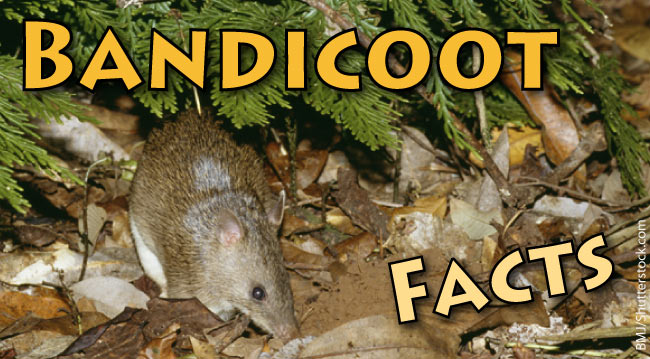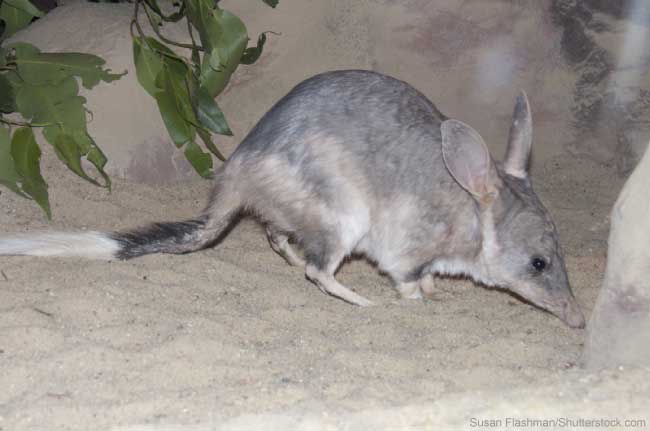This page contains bandicoot facts, and is part of our Australian Animals series. Many people think that there is one animal called a bandicoot. In fact, bandicoot is the name of a type of animal. There are around 20 types of bandicoot. Let’s learn about some of them…
Bandicoot Information
Bandicoots are small to medium-sized marsupials. They are only found in the wild in and around Australia and New Guinea.
As we’ve found, the word bandicoot doesn’t refer to a specific animal; rather, it’s a type of animal. Bandicoot is the name given to animals in the order Peramelemorphia. (An ‘order’ is a way of grouping animals that have similar characteristics. See our article on Animal Classification for more info.)
Physical Description / Statistics
All bandicoots share a number of characteristics: they are all fairly small, four-legged creatures, and are all nocturnal. They tend to look rather ‘rat-like’, with long noses and hunched backs.
Bandicoots use their powerful rear legs to bound around.
Bandicoots are rather solitary animals, and usually only get together to have babies.
Being marsupials, after being born, baby bandicoots crawl into a pouch in the front of the mother’s body. (The most well-known marsupials are kangaroos and wallabies.)
It only takes around 12 days for a baby bandicoot to be ready to be born. This is the shortest time for any mammal. After being born, bandicoots spend around 8-10 weeks in their mother’s pouch. During this time they grow fur, and their eyes open.
At 5 months old, bandicoots reach adulthood and are ready to have their own babies.
Bandicoot Predators
Bandicoots are small creatures, and are often prey items for predators such as birds, cats, foxes, dingoes and snakes.
Bandicoot Facts: Types Of Bandicoot
The most well-known types of bandicoot are the long-nosed bandicoot, the short-nosed bandicoot, and the bilby.
Long-Nosed Bandicoots
There are several types of Long-nosed bandicoot. One is actually called the long-nosed bandicoot, and is a dull brown color. Others include the eastern barred bandicoot, which has stipes on its rump and the desert bandicoot, which is now presumed extinct.
Learn more about the eastern barred bandicoot in the video below:
Short-Nosed Bandicoots
Short-nosed bandicoot species include the golden bandicoot, which is now classed as ‘vulnerable’ on the IUCN Red List. The golden bandicoot can now only be found in northwest Australia, and on nearby islands.
Bilbies
Bilbies are small, long-eared bandicoots. Unlike other bandicoots, they are good burrowers and live in warrens. The lesser bilby became extinct fairly recently (in the 1950’s), and the greater bilby is now classed as ‘vulnerable’.
10 Bandicoot Facts
- Most bandicoots are nocturnal (active at night).
- Bandicoots are any animal in the order Peramelemorphia.
- Bandicoots are marsupials, and raise their young in pouches in the mother’s body.
- Bandicoots take the shortest time of any mammal to gestate (get ready to be born). They are usually born after around 12 days.
- Most bandicoots are small animals.
- Bandicoots bound around using their powerful hind legs.
- Bandicoots reach maturity quickly.
- Bandicoots don’t live particularly long: around 3 years in the wild.
- Bandicoots are omnivores, which means they eat meat and plants. Favorite bandicoot snacks include insects, nuts and seeds.
- Several species of bandicoot are endangered, and some are critically endangered.
We hope that you have enjoyed reading these bandicoot facts. You can learn about other amazing Australian animals here.




